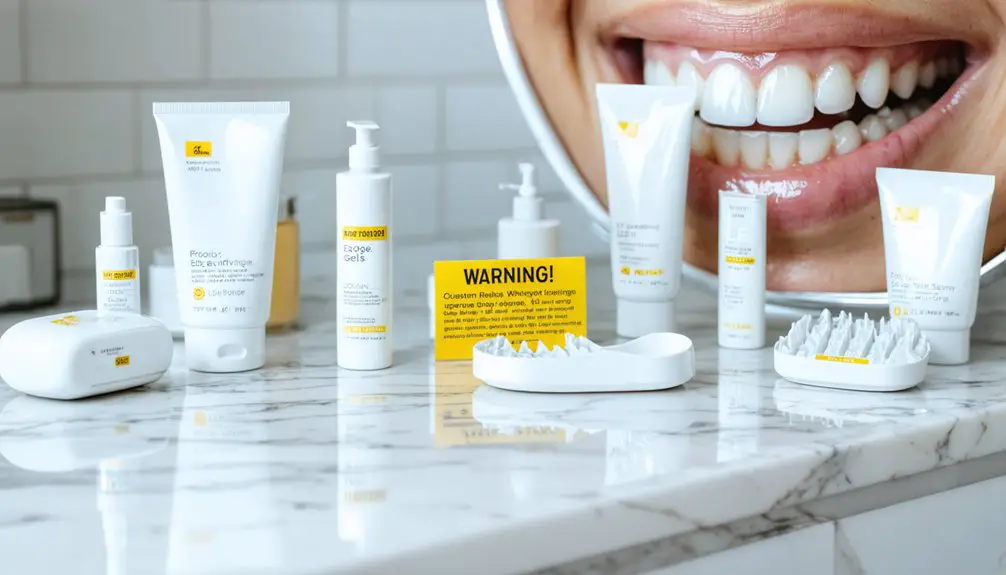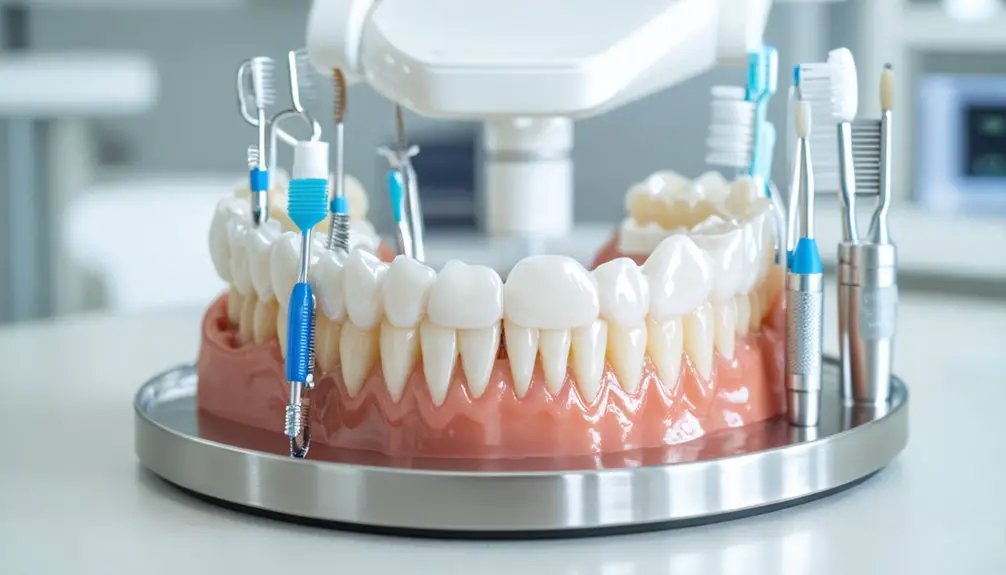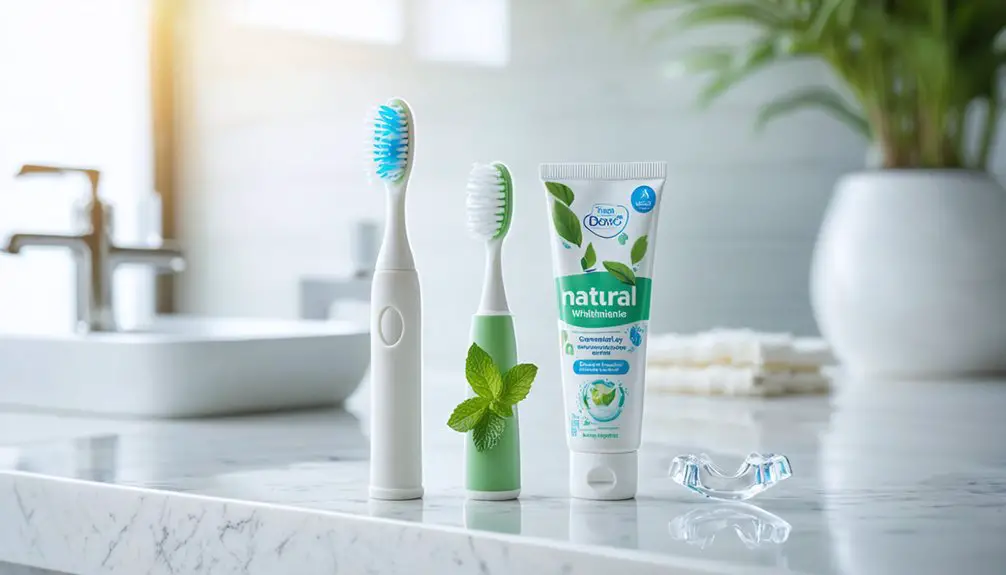You’ll face several risks when using teeth whitening products, including tooth sensitivity affecting up to 62% of users and gum irritation in up to 46% of cases. Chemical burns can cause white patches and inflammation, while repeated treatments may erode enamel and weaken your tooth structure. Uneven results are common, especially with DIY treatments. Working with a dental professional helps minimize these risks and guarantees safer treatment options.
Key Takeaways
- Tooth sensitivity affects up to 62% of patients using whitening products, especially those with higher peroxide concentrations.
- Chemical burns can cause white patches, inflammation, and peeling of gum tissue, affecting 10-46% of users.
- Repeated whitening treatments can weaken tooth enamel, leading to erosion and increased porosity.
- DIY whitening kits may contain dangerous peroxide levels exceeding 33%, risking severe tissue damage.
- Uneven results and visible mismatches can occur, especially when whitening teeth with existing dental work.
Common Side Effects of Dental Bleaching
While teeth whitening treatments have become increasingly popular, they commonly produce several side effects that patients should understand before pursuing treatment.
The most frequent issue you’ll encounter is tooth sensitivity, affecting up to 62% of patients, especially when using higher peroxide concentrations. This sensitivity typically occurs early in the treatment and resolves within hours to weeks after completion.
Soft tissue irritation presents another significant concern, impacting 10-46% of users. You may experience gingival inflammation, burns, or blisters, particularly during in-office procedures using concentrated peroxide solutions. Recent studies show that gingival irritation rates are significantly higher with in-office treatments at 35.7% compared to at-home treatments at 14%. Clinical data demonstrates that adverse events resolve within 3 days of stopping treatment.
Additional side effects can include jaw discomfort from prolonged procedures and, rarely, mild systemic reactions like throat irritation. While most effects are temporary and manageable, they’re more likely to occur in patients with existing gingival recession or those using tobacco products.
Long-Term Impact on Tooth Structure
Beyond the immediate side effects of teeth whitening, long-term structural changes to your teeth merit careful consideration. Research shows whitening agents can affect your tooth structure through enamel erosion and dentin penetration, potentially compromising dental health over time.
Key structural impacts you should understand:
- Whitening can alter enamel’s surface integrity, creating shallow depressions and increased porosity that may reduce its protective function.
- Repeated treatments may weaken the bond strength between your tooth enamel and future dental restorations, requiring waiting periods before procedures.
- While bleaching agents penetrate to dentin, breaking down internal stains, they can temporarily modify surface chemistry and mineral content. Saliva and fluoride can help restore mineral content to bleached surfaces over time.
Your enamel thickness plays an important role in whitening outcomes, with thinner enamel facing higher risks of permanent structural changes through repeated treatments. When done under professional supervision, whitening treatments use controlled concentrations to minimize potential damage to tooth structure.
Understanding Chemical Burns and Gum Sensitivity
Chemical burns and gum sensitivity represent significant risks when using teeth whitening products, especially those containing high concentrations of hydrogen peroxide.
When you experience chemical burns, you’ll notice white patches, inflammation, or peeling of your gum tissue – similar to a mild sunburn. These burns are typically reversible with proper care and limited exposure.
You’ll find that gum irritation commonly manifests as stinging or burning sensations along your gum line during or after treatment. According to the British Dental Association, some DIY whitening kits have been found to contain dangerous peroxide levels exceeding 33%. Using a custom-fit tray during whitening treatment helps minimize gel leakage onto sensitive gum tissue.
While professional whitening procedures use protective barriers to minimize these risks, at-home products require careful application to avoid soft tissue contact. Over-the-counter products with unclear chemical compositions pose greater risks than dentist-supervised treatments.
If you experience persistent symptoms like intense localized pain or blistering, seek immediate professional dental evaluation.
Aesthetic Challenges and Uneven Results
The pursuit of whiter teeth can lead to unexpected aesthetic complications, particularly when whitening treatments produce uneven or inconsistent results. Your teeth’s natural variations in enamel thickness, density, and mineral composition can create significant aesthetic challenges during the whitening process. Genetics can cause teeth to have naturally darker tones, making uniform whitening results more difficult to achieve.
Key factors contributing to uneven results include:
- Improper application of whitening products, especially with ill-fitting trays or strips that don’t provide uniform coverage.
- Existing dental work like crowns or veneers that won’t respond to whitening agents.
- Deep-set stains beneath the enamel that resist surface treatments.
Your tooth edges may whiten faster than inner areas, creating a noticeable color mismatch. Regular dental cleanings and check-ups are essential to identify potential whitening issues before they become problematic.
While professional treatments offer more controlled application and better outcomes, even they can’t guarantee perfectly uniform results due to natural tooth variations.
Safety Guidelines and Professional Recommendations
While teeth whitening products offer compelling cosmetic benefits, following proper safety guidelines and professional recommendations remains essential to avoid complications and achieve ideal results.
Professional guidance and safety protocols are crucial when using teeth whitening treatments to ensure both optimal results and minimal risks.
You should begin with a professional consultation to assess your dental health and determine the most suitable whitening approach for your specific needs. Your dentist can evaluate existing conditions like sensitivity or gum disease that might affect treatment safety. Professional treatments use higher strength peroxide formulations compared to retail options.
In product selection, prioritize ADA-approved options and follow usage instructions meticulously. Taking breaks between treatments helps minimize sensitivity and promotes healthier outcomes during the whitening process. You’ll need to avoid acidic foods post-treatment and use desensitizing toothpaste to protect your enamel.
If you experience prolonged sensitivity or gum irritation, discontinue use immediately and contact your dental provider.
Remember that dentist-dispensed products typically contain safer peroxide concentrations than some over-the-counter alternatives, offering better controlled and monitored results.
Frequently Asked Questions
Can Teeth Whitening Affect Existing Cavities or Dental Work in Progress?
You shouldn’t whiten teeth with untreated cavities or during dental restoration work. The whitening agents can cause severe cavity sensitivity, damage your dental work, and require more extensive treatment later.
How Long Should I Wait Between Professional Teeth Whitening Treatments?
You should wait 6 months to 1 year between professional whitening treatments to prevent teeth sensitivity and protect enamel health. Your whitening frequency depends on your individual needs and dental condition.
Are Natural Teeth Whitening Alternatives Like Charcoal or Baking Soda Safer?
Like sandpaper on wood, natural ingredients like charcoal and baking soda can permanently damage your enamel. You’ll face greater safety concerns with these abrasive DIY methods versus professional treatments.
Do Teeth Whitening Products Have Different Effects on Children Versus Adults?
You’ll find children’s dental health is more vulnerable to whitening damage due to thinner enamel and larger pulp chambers, while adult whitening effectiveness benefits from mature, resilient tooth structure.
Can Teeth Whitening Cause Permanent Changes to Taste Sensation or Saliva Production?
Even though you might temporarily notice orange juice tasting bitter after whitening, there’s no scientific evidence that teeth whitening products cause permanent changes to your taste sensation or saliva production. These effects are reversible.
References
- https://www.cornerstonedentistryvan.com/the-hidden-dangers-of-teeth-whitening-treatments/
- https://www.dentistryofwestbend.com/teeth-whitening-risks-and-side-effects/
- https://narrewarrendentalcare.com.au/risks-of-teeth-whitening-what-you-need-to-know-before-getting-started/
- https://harborcreekdental.com/side-effects-of-teeth-whitening/
- https://pmc.ncbi.nlm.nih.gov/articles/PMC4058574/
- https://www.nature.com/articles/sj.bdj.2013.1047
- https://ec.europa.eu/health/scientific_committees/opinions_layman/en/tooth-whiteners/l-3/5-tooth-whitening-products.htm
- https://www.loudfamilydentistry.com/blog/teeth-whitening-related-statistics-on-effectiveness-and-sensitivity-incidence
- https://pmc.ncbi.nlm.nih.gov/articles/PMC4229680/
- https://biomedres.us/fulltexts/BJSTR.MS.ID.005694.php



